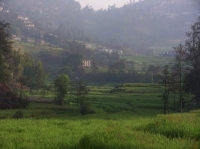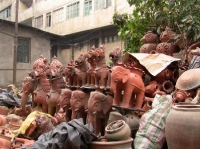Ayurveda classifies the major components of the body as serum (rasa), blood (rakta), flesh (mamsa), fat (medas), bone (asthi), marrow (majja) and semen (shukra), collectively called the sapta (seven) dhatus (tissue elements). It is important to note that these are broad categories, and each dhatu includes several different tissue types. For example, the tissue element of flesh (mamsa) includes the nerves, skin, tendons, membranes and glands.
In general, the body is said to contain ten handfuls of water, nine handfuls of serum, eight handfuls of blood, five handfuls of fat, one handful of marrow and a half handful of semen. Besides these ingredients, the body also has quantities of by-products such as bile and the two types of ojas (vital water), all of which should be in proportion. If the dhatus and its component parts become unhealthy it can be a cause for many diseases including anemia, weight loss, thrombosis, arteriosclerosis, obesity, edema, varicosis, osteoporosis, impotence, and sterility.
Ayurvedic Metabolism
 Serum (rasa) is the essence of digested food. It goes to the liver through the portal vein of the gastrointestinal system, and from there to the heart where it circulates through the arteries for the nourishment of the bodily tissues. Ayurveda states that the bodily fire (agni) causes the food nutrients to change their physical properties over the course of a thirty day cycle in order to nourish each part of the body. To understand this process it is important to remember that the nutrients extracted from food are understood not by their biochemical forms, but by their physical properties as defined by Ayurveda.
Serum (rasa) is the essence of digested food. It goes to the liver through the portal vein of the gastrointestinal system, and from there to the heart where it circulates through the arteries for the nourishment of the bodily tissues. Ayurveda states that the bodily fire (agni) causes the food nutrients to change their physical properties over the course of a thirty day cycle in order to nourish each part of the body. To understand this process it is important to remember that the nutrients extracted from food are understood not by their biochemical forms, but by their physical properties as defined by Ayurveda.
The physical properties of serum are first active for five days in the blood. Then the blood (rakta) mixed with nutritive serum separates out nutrients with the physical properties of flesh (mamsa) so it can nourish the muscular tissues. The nutrients with the physical properties of flesh (mamsa) are active for five days, after which the greasy properties of the flesh starts to separate out and begins to nourish the fatty tissues (medas) of the body. The activity of the nutrients with greasy properties continues for five days and then begins to nourish the bone (asthi), with the cartilage especially absorbing the greasy elements. After five more days the greasy elements gradually change physical properties and begin to nourish the oily marrow (majja). Then, after another five days the essence of the oily marrow converts to help generate semen (shukra) and then ojas (vital water), which spreads throughout the whole body. Thus over the course of 30 days the digested food is converted from one form into another to nourish all of the bodily tissues (dhatus).
As the serum begins to enter the tissues mucus forms as a byproduct. If the digestive process and the foods consumed are healthy, the mucus is sweet in taste and contains nutrients useable by the body. Healthy mucus coats and moistens the tissues. If the digestive process is unhealthy, the mucus becomes salty in taste and is excreted from the body. In the same way bile is the by-product of blood, which in a healthy state is pungent in taste and promotes the heat required for metabolism. In the unhealthy state bile is bitter and acid in taste and is excreted from the body. The by-product of semen (shukra) is the vital water (ojas) that is necessary for the proper functioning of the nervous system, brain and heart. Ayurveda distinguishes between two types of ojas: one which is intrinsic to life and remains in the heart without change (para ojas), and one which fluctuates depending on dietary and lifestyle habits (apara ojas). The intrinsic ojas of the heart is measured as eight drops which are yellow in color, whereas the circulating ojas is measured as one half handful and is white in color.
Rasadosha (Pathogenic defects of the serum)
The serum or plasma becomes pathogenic if its properties change making it too greasy, heavy or cold. In this state many physical problems can develop, including loss of appetite, loss of sense of taste on the tongue, nausea, heaviness, drowsiness, bodyache, fever, blurred vision, anemia, blockage in the duct system, heart attack, impotency, weakness, loss of weight, indigestion, grey hair and wrinkling of the skin.
Pathogenic defects of the serum or plasma are generally treated with the timely application of emetic remedies, enema, laxative remedies, herbal snuff made from Katphalam bark (box byrtle / Myrica nagi), regulation of water consumption, exposure to windy and sunny places, digestive remedies, fasting and exercise. Foods or remedies that are heavy to digest, constrictory or greasy in property have to be strictly prohibited.
Rasakshaya (Deficiency of serum or plasma)
 Deficiency of serum or plasma is caused by weak function of the artery system and the heart that causes physical and mental weakness. It is treated with digestive remedies and general rasayanas, with specific remedies chosen on the basis of the presenting signs and symptoms.
Deficiency of serum or plasma is caused by weak function of the artery system and the heart that causes physical and mental weakness. It is treated with digestive remedies and general rasayanas, with specific remedies chosen on the basis of the presenting signs and symptoms.
Rasavriddhi (Excess of serum or plasma)
Excessive amount of serum or plasma in the blood causes the symptoms of nausea and watery mouth. It is treated with the same methods used for pathogenic defects of serum. In ancient times bloodletting and leeches were also used.
Raktadosha (Pathogenic defects of the blood)
Pathogenic defects of blood exist when the properties of blood become imbalanced and excessively acid, greasy, hot or liquid. In this state many diseases can develop, including stomatitis, red eyes, hematorrhea, bloody smell of mouth and nose, erysipelas, abscess, hematuria, gout, menorrhagia, hot sensations, headache, weakness, acidity, anger, delusion, intoxication, drowsiness, blurred vision, skin diseases, leprosy, boils and pimples, and liver and spleen diseases.
Pathogenic defects of blood in general, are treated with timely application of laxative remedies, fasting, venesection and the remedies for hematorrhea (page 1). It is also necessary to strictly prohibit foods or remedies that are acidic or increase acidity, greasy, dilatory in effect (increasing heat in the circulation), and excessively liquid in nature. Some specific medicines for blood defects include:
- Atirasa root/plant (dandelion /Taraxacum officinalis)
- Brahmi leaf/root (gotu kola / Hydrocotyle asiatica /Centella asiatica)
- Chandanam wood (white sandalwood / Santalum album)
- Chandraprabha vati
- Gandhaka Bhasma (purified sulfur oxide)
- Guduchi stem (Tinospora cordifolia)
- Haridra Amalirasena
- Haritala Bhasma (orpiment / purified yellow arsenic trisulphide).
- Kanchanara bark (mountain ebony / Bauhinia tomentosa)
- Kharjura fruit decoction (date / Phoenix dactylifera)
- Lauhasava
- Manashila Bhasma (purified realgar)
- Mandura Bhasma (purified iron ore oxide)
- Nilotpalam flower (blue lotus / Iris nepalensis)
- Nimba leaf (neem / Azadirachta indica)
- Nirgundi plant (Vitex negundo, white)
- Punnaga bark (Itching tree / Schima wallichii)
- Rakta Chandanam wood (red sandalwood / Pterocarpus santalinus)
- Sanapushpi seeds (rattle-box / Crotolaria juncea)
- Shilajita
- Tinduksthi kasmarya
- Triphala (Phyllanthus emblica / Terminalia belerica / Terminalia chebula)
- Varuna bark (Three-leaved caper / Crataeva religiosa)
- Vasaka leaf (Malabar nut / Adhatoda vasica)
A reliable formula for raktadosha is the standard compound Avipattikara churna.
Raktavriddhi (Excess blood)
An excessive amount of blood is caused by pathogenic defects of blood and promotes the same sorts of problems. It is treated with the same methods used for pathogenic defects of the blood (raktadosha).
Raktakshaya (Deficiency of blood)
Deficiency of blood can be caused by poor digestion, toxins that kill red blood cells, blood loss or other reasons. This generally causes a weakness in the functioning of the vein system, promoting a desire for sour foods and a cooling environment. The blood can be restored with digestive remedies, blood restoratives such as Dadimadi churna, Bhallataka Rasayana and iron compounds such as Mandura Bhasma (purified iron rust oxide). If untreated blood deficiency can lead to Pandu (anemia, see below).
Additional headings in this chapter*
Pandu (Anemia)
Swayathu (Edema / Swelling)
Raktapitta (Hematorrhea / Hemorrhage)
Vatarakta (Gout)
Daha (Hot Sensation)
Mamsadosha (Pathogenic Defects Of Muscular Tissues)
Mamsakshaya (Muscular Atrophy)
Medodosha (Pathogenic Defect Of Fat)
Medokshaya (Weight Loss / Cachexia)
Medovriddhi (Obesity)
Asthidosha (Pathogenic Defect Of Bone)
Majjadosha (Pathogenic Defects Of The Marrow)
Majjakshaya (Deficiency Of Marrow)
Ojakshaya (Vital Deficiency)
*To acquire the complete contents of “Ayurveda In Nepal: The Bajracharya Samhita” please click here.
0 Responses to “Diseases of Tissue Metabolism”